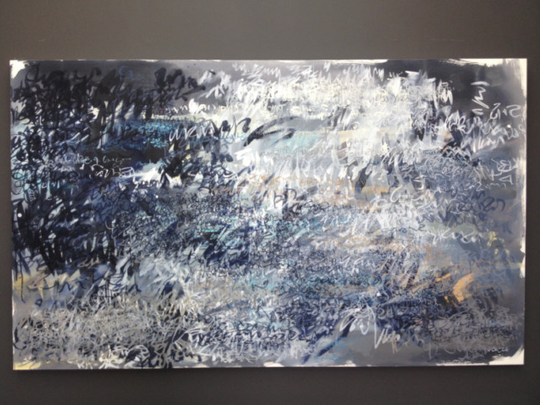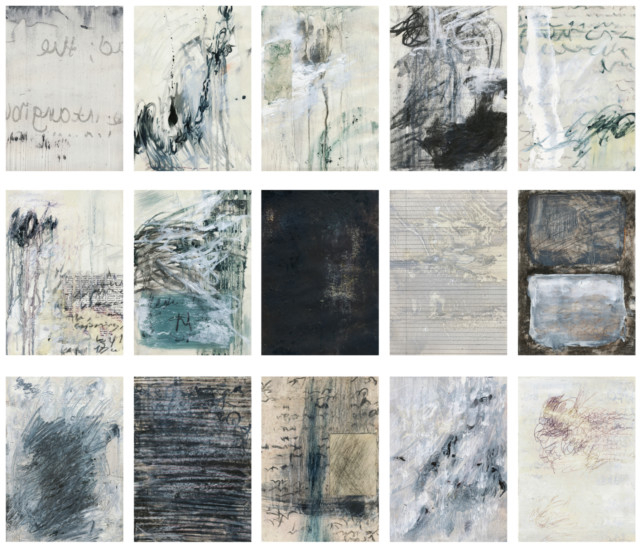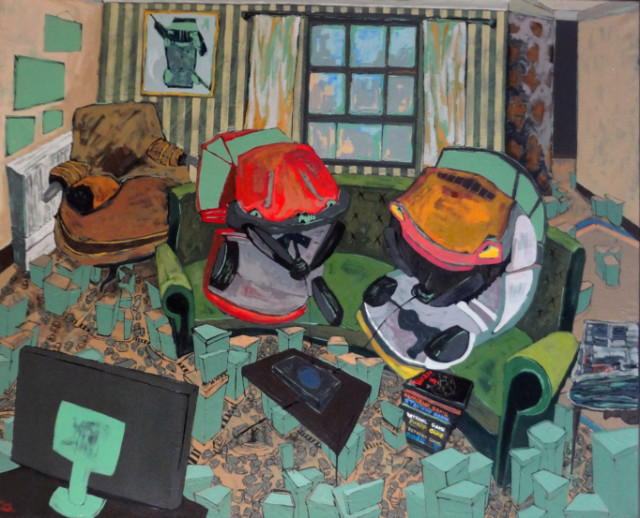
African artists Alison Coulthurst, Grace Kotze, Helen Teede and Andrew Verster are interested in exploring the relationship between painting and language. The four artists have used the power of abstract writing to express themselves in their joint show, “Scripts of Our Unspoken Words”.
The words in their paintings are often barely legible and seemingly meaningless, but the colours, fonts, textures and implied meanings of the words are like mind maps, subtly revealing the thoughts and emotions of each artist. The mysterious words also invite viewers to create their own interpretations of the paintings.
Zimbabwean artist Coulthurst’s paintings are filled with bright colours, interesting textures, collaged pieces of canvas and Africa-inspired figures with bright red lips. The paintings have titles such as “Letting Go”, “Life is Life” and “You could Chase a Summer Day”, and these words are painted or scratched onto the canvases.
“These titles are inspired by songs, dreams and positive emotions, but I am not interested in revealing their exact meaning. Rather than stimulating interrogations about the significance of the words, I want to invite viewers to feel the forms, colours and energy in my paintings, and to imagine a story of their own,” she says.
Teede, who is also from Zimbabwe, emphasises the expressive bond between writing and painting in her body of work titled “Poetry painting”. The series includes assemblages of blank and ruled sheets of white paper on which the artist has scribbled her own poems in a monochromatic palette of greys and blacks. The illegible letters are like brush strokes.
“My work shows the relationship between the world of painting and writing by accentuating the destruction of the whiteness of a page or canvas as one writes or paints on it, and transforming it into a tantalising mystery that provokes questions and curiosity,” she says.
South African artist Kotze has a different perspective on words because she is dyslexic and has struggled with reading and writing. In her “Internal Markings” series she has broken the barriers of her learning disability by transforming writing into an enjoyable experience. The canvases in her autobiographical paintings are covered with meaningless words representing an internal dialogue that conveys her emotions through the shapes, colours and intensity of the strokes.
Verster, who is also from South Africa, has always been interested in exploring the ornate decorative elements of spiritual deities and iconography. And in recent years he has become fascinated with ancient cultures, especially the practice of body marking such as tattooing, scarification and body painting. He is showing works from his well-known series “Skin Markings” featuring paintings on panels of wax-impregnated tissue paper.
The artist has used a hot iron to apply the wax, which transforms the tissue paper into a skin-like translucent material and works as a laminate holding together layers of paper to form large sheets. These have been stained with materials such as coffee, tea, turmeric and ink to create the look and feel of old parchment. Each painting references the body, which is covered with patterns, symbols and words inspired by tribal markings from cultures where body marking is an important symbol of identity and heritage.
The 75-year-old artist has also taken inspiration from his huge collection of decorative spiritual objects acquired during his travels around the world. His exuberant, childlike paintings are thus based on his personal knowledge of African culture as well as his memories and experiences of other cultures. The patterns represent external and internal markings; and they speak not about any specific culture, but about universal dreams and the sacredness of life itself.
“Skin is one of the ideas behind these works, which comes from memories of holding the mummified hand of a 12th century Irish knight in Dublin; of drawings I did of Inca mummies trussed in the foetal position in the Cusco Museum; and more recently, my research on local tattoo parlours and the intricacies of this revived art.
“Lurking in my mind are other, sinister associations that the word ‘skin’ conjures such as the association with reliquaries where a holy piece of body is enshrined. The skin-like quality of these artworks, and the tattoo marks, refers simultaneously to the exterior body as well as to internal markings. Hence these fragile works provide a bridge between interior and exterior space, between the private and the public,” the artist says.
The show will run at Showcase gallery, AlSerkal Avenue until September 13.
CELEBRATION OF EGYPTIAN ART
Gallery Ward is marking its first anniversary in Dubai with an exhibition of selected works by eight prominent Egyptian artists. The show, titled “Selections from the Contemporary Egyptian Art Scene: Volume 2” is a sequel to the gallery’s inaugural exhibition in the city, and features paintings, installations and sculptures by Ahmad Kassim, Armen Agop, Atef Ahmad, Ayman Al Semary, Essam Darwish, Essam Marouf, Mohammad Ardash, and Nagla Samir.
“This show is a celebration of Egyptian culture and creativity with the diversity of the artists’ subjects, media and styles reflecting today’s Egyptian aesthetic. The gallery came to Dubai with the aim of introducing the best of Egyptian art to the multicultural community of art lovers in the UAE, and throughout this year we have hosted shows by established and emerging Egyptian artists. We hope this show will provide viewers with a deeper understanding of contemporary Egyptian art, and foster a more relevant dialogue around it,” curator Ehab Ellaban says.
The show will run at Gallery Ward, Al Quoz until August 28
–Jyoti Kalsi is an arts enthusiast based in Dubai













